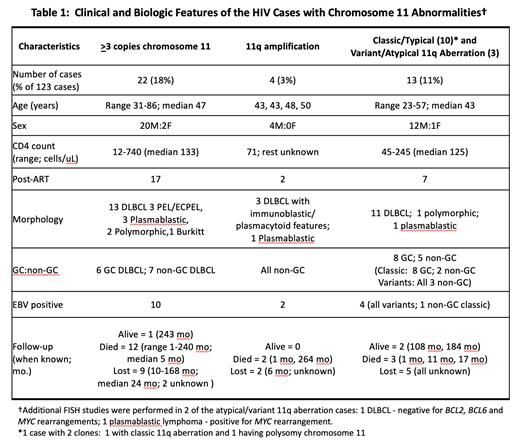High grade B-cell lymphoma with 11q aberration/diffuse large cell lymphoma with 11q aberration (HGBL-11q; previously classified as Burkitt-like lymphoma with 11q aberration, a provisional category in WHO 4-revised) is a relatively new entity recognized by both the WHO-5 and International Consensus Classification (ICC). These lesions show high grade morphology which is often, but not always, similar to Burkitt lymphoma (BL), and a genetic composition that is similar to that of germinal center (GC) derived diffuse large cell lymphoma (DLBCL). While these lymphomas have been described in immunocompetent patients, where they occur usually in children/adolescents and adults under 60 years, they have been only been rarely described in HIV positive patients. In this study we examined the incidence of the 11q aberration in HIV positive lymphomas.
Four tissue microarrays (TMA) containing 144 HIV-associated lymphomas (HIV-NHLs; 57 pre-ART; 16 females; median age 44 years) were examined for the 11q aberration by FISH using the ZytoLight SPEC 11q gain/loss Triple Color Probe (ZytoVision GmbH, Fischai1, Germany). The cases were classified morphologically, evaluated for cell of origin (Hans' criteria; immunohistochemistry for CD10, BCL6, MUM1), the presence of Kaposi sarcoma herpesvirus (KSHV; immunohistochemistry for LANA) and the Epstein Barr virus (EBV; in situ hybridization; EBER probe). Clinical data, when available, was obtained from the EMR.
Of the 144 cases, 123 (85%) were evaluable by FISH, including 76 DLBCLs, 10 BL, 14 primary effusion lymphoma (PEL)/EC-PEL, 7 plasmablastic lymphomas, 1 marginal zone lymphomas and 15 polymorphic lymphoproliferative lesions. Four abnormal patterns were seen (Table 1) in 39 cases (32%): polysomy (≥ 3 copies of chromosome 11), 11q23q24 amplification (≥10 copies), variant or atypical 11q aberration (11q24 loss only) and classic or typical 11q aberration (11q23 gain and 11q24 loss).
Although survival data was available in only a proportion of HIV+ patients with HGBL-11q, these patients showed in general better survival than patients with other chromosome 11 abnormalities (Table 1) and appear to trend to better survivals compared to HIV+ lymphoma patients without the 11q aberration (alive: 11-202 mo; median 73 mo; died 1 - 45 mo; median 6 mo).
Our results demonstrate that chromosome 11 abnormalities are not an uncommon finding in HIV positive lymphoproliferative lesions. Furthermore, although previously only rarely described in HIV+ individuals, HIV-associated lymphomas with the classic or variant 11q aberration is not a rare event. As in immunocompetent patients, the HIV-associated high grade B cell lymphomas with 11q aberration are usually of germinal center origin and EBV negative and in at least some patients are associated with a relatively good prognosis. Thus, these findings indicate that HIV-associated high grade B cell lymphomas with 11q aberration exhibit similar biologic features as those arising in immunocompetent individuals.
Disclosures
Chadburn:Leica Biosystems: Consultancy; Boehringer Ingelheim Pharmaceuticals, Inc.: Consultancy; Medical College of Wisconsin: Honoraria.


This feature is available to Subscribers Only
Sign In or Create an Account Close Modal